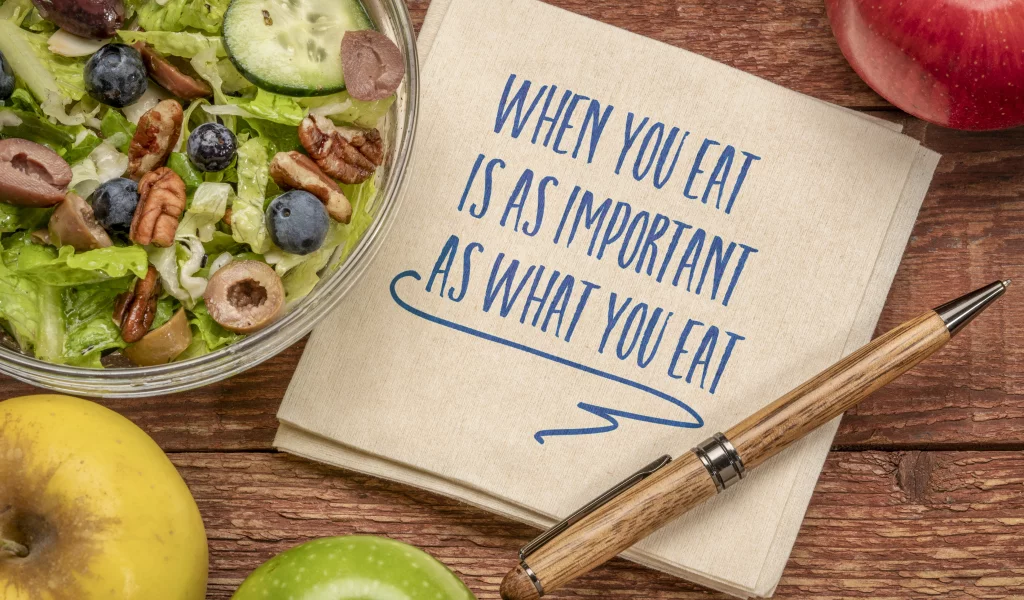
Time-restricted eating
Throughout the course of our program, we focus on keeping your blood sugar level stable. This can be influenced by choosing the right food but also by limiting the moments of eating. Time-restricted eating may help you with this and offers quite some benefits.
Reasons to consider time-restricted eating
Over the past years, time-restricted eating or intermittent fasting has become more and more popular, but the method is nothing new. People have been, and still are, fasting for centuries in the context of religion to bring back balance in body and mind. In prehistoric times when we didn’t have a fridge, freezer, or storage, we were dependent on what food was available at that specific moment. Periods of feasting were alternated with periods of fasting. And that schedule is exactly what we want to mimic with intermittent fasting.
Intermittent fasting has great advantages for your body and health. To name a few:
- You become more metabolically flexible: your body switches between sugar and fat burning easier;
- Your insulin sensitivity increases;
- You’ll lose weight more easily;
- Your body produces more growth hormones, which will lead to muscle growth when exercising;
- You’ll experience more energy and focus during fasting periods;
- Your digestion will improve; since your organs get time to rest and relax between meals, your pancreas will be able to improve its digestive function through the production of digestive enzymes;
- Your microbiome changes for the better: i.e. during fasting the number of butyrate-producing bacteria increases, which leads to more energy production for your gut cells;
- You will avoid constant inflammation; after each meal, you take there is an inflammatory response since pathogens are likely to be ingested while eating. By limiting the number of meals per day, you will reduce the inflammatory response;
- Your body reaches a state of autophagy: after a period of fasting for 14 hours, your body starts to clean and recycle your cells. This process of autophagy may slow down the aging process and keeps your cells younger!
Autophagy is a kind of magic – it may turn back your metabolic clock. When your body is in a fasted state, your cells begin to eat themselves. Your body will devour only damaged cells for food, leaving you rejuvenated with healthy cells.
So how do you start intermittent fasting?
- First of all, start slowly. If you still find it difficult to go through the day without snacking, it may be a bridge too far to start intermittent fasting immediately. Also when you regularly experience hypoglycaemia, it may be better to first start to change the ratio of carbs, protein, and healthy fats. Start by reducing the number of carbs and increase the amount of healthy fats. See if this will stabilise your blood sugar level.
- Reduce the number of eating moments. If you are used to having 3 meals and 2-3 snacks per day, reduce the number of snacks and focus on getting enough protein and healthy fats so you don’t need to snack.
- Start with the 12-12 method. You will start eating at 8 o’clock in the morning and you finish eating at 8 at night. As soon as this feels right, start to eat later in the morning which ultimately results in skipping breakfast. Then you move to the next level.
- Continue with the 16-8 method. You will skip breakfast and start eating by noon (you could consider to postpone your breakfast til noon). Then you have an 8-hour feeding window, which closes at 8pm. Don’t eat anything after 8 pm and limit yourself (during your fast) to drinking water and herbal or ginger tea. In the morning during your fast, you are allowed to take two espressos (no sugar or milk should be added during your fast);
- Drink plenty of fluids during your fast. So, stick to water, herbal or ginger tea or coffee (black or espresso, no milk or sugar). Coffee is known to stimulate the progress of autophagy!
- Be committed to your goals - intermittent fasting is about changing your daily habits. Give yourself time to adapt to these new habits. Keep track of your progress. This is a great way of keeping yourself motivated. Also, reward yourself in different ways: treat yourself to a nice massage or other wellness activity like going to the sauna or going for a forest or beach walk and enjoy your time feeling connected to nature.
- Tip: take your fasting hours into account when making appointments not to challenge yourself too much!.
Different fasting methods
The 16-8 method is the most commonly used way of time-restricted eating. It is easy to fit into your life and it doesn’t have to intervene with your social lifestyle. But of course, there are other possibilities, more strict ways to fast:
- 24 hour fasting. During one or two days of the week, you eat absolutely nothing. The rest of the week you can eat what you want. This way of fasting creates more flexibility. It gives you the opportunity to schedule this/these day(s) of fasting whenever suits you best and it doesn’t require a lot of energy from you. But not eating all day long can be hard to keep up with and may lead to cravings during the other days of the week.
- Alternate day fasting. During the first 24 hours of fasting, you are allowed to eat a maximum of 500 calories which be consumed during 1 meal or spread out over the day. The next day you may eat normally which is the benefit of this way of fasting. The following day the process repeats itself. Living on 500 calories may be tough, just like the 24 hours of fasting is.
- The 5:2 method. 2 Days per week you restrain yourself from eating 500 calories per day, the rest of the week you may eat normally. Beware that you eat healthy the other days and that you don’t fill up on junk food the remaining days due to cravings.
- The warrior method, the 20-4 method. You fast 20 hours per day and consume one major meal per day. You can do this this all days of the week. The advantage of this kind of fasting is that you’ll lose weight quickly and you won’t have to think about food when you are really busy. The downside is that it is strict and hard to keep up, especially when you have to make physical efforts during the day.
As you can see, intermittent fasting has a lot of advantages, but it doesn’t determine what you can eat. Studies show that you’ll get the best results if you combine intermittent fasting with healthy food and lifestyle so please follow our delicious, healthy recipes so you can combine all benefits!
Disclaimer:
Intermittent fasting is not suitable for everyone. People that are underweight, pregnant, breastfeeding, suffering from any eating disorder or suffering from diabetes 1 or any other disease should consult their doctor, before starting with time-restricted eating. Intermittent fasting is not recommended either for (professional) sporters or people doing heavy work. If you experience hypoglycaemia or other blood sugar level problems, always consult your physician.


